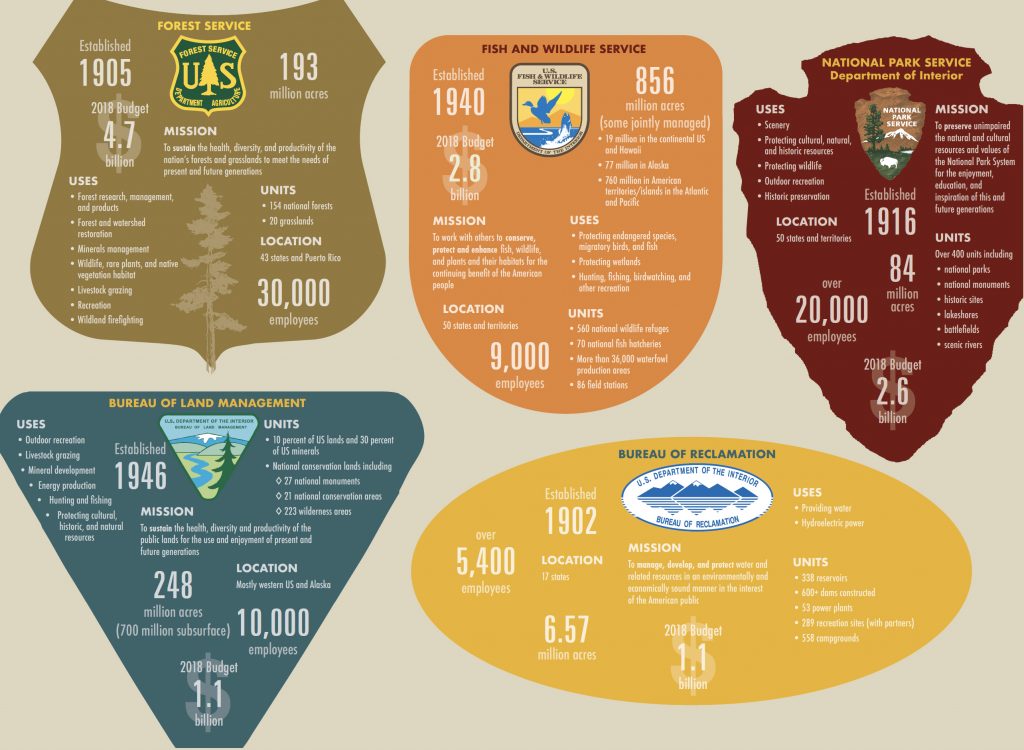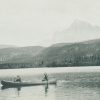The United States of America is unique in the world for its vast system of federal public lands, which make up more than a quarter of the country’s land area. Those federal lands, mostly concentrated in the 11 westernmost states and Alaska, span everything from rivers and canyons to sagebrush steppe and alpine peaks. They include protected national parks and monuments as well as productive energy fields and expansive rangelands. They host fish and wildlife habitat, timber production, the watersheds that supply our cities, and an ever-expanding range of recreational experiences.
Federal lands are a source of both experiences and resources. In 2017, companies paid more than $6.9 billion for resources extracted from federal lands, mostly oil and gas. That money goes to the states and American Indian tribes; to the General Treasury; to the Reclamation, Land and Water Conservation, and Historic Preservation Funds; and elsewhere.
Here’s a breakdown of our federal public lands for reference as you read the rest of this issue.
| Department | US Dept. of Agriculture | Department of Interior | |||
| Agency | US Forest Service | Bureau of Land Management | US Fish and Wildlife Service | National Park Service | Bureau of Reclamation |
| Year est. | 1905 | 1946 | 1940 | 1916 | 1902 |
| Acres | 193 million | 248 million (700 million subsurface) | 856 million (some jointly managed)
19 million in the continental US and Hawaii 77 million in Alaska 760 million in American territories/islands in the Atlantic and Pacific |
84 million | 6.57 million |
| 2018 budget | $4.7 billion | $1.1 billion | $2.8 billion | $2.6 billion | $1.1 billion |
| Mission | To sustain the health, diversity, and productivity of the nation’s forests and grasslands to meet the needs of present and future generations | To sustain the health, diversity and productivity of the public lands for the use and enjoyment of present and future generations | To work with other to conserve, protect and enhance fish, wildlife, and plants and their habitats for the continuing benefit of the American people | To preserve unimpaired the natural and cultural resources and values of the National Park System for the enjoyment, education, and inspiration of this and future generations | To manage, develop, and protect water and related resources in an environmentally and economically sound manner in the interest of the American public |
| Uses | Forest research, management, and products
Forest and watershed restoration Minerals management Wildlife, rare plants, and native vegetation habitat Livestock grazing Recreation Wildland firefighting |
Outdoor recreation
Livestock grazing Mineral development Energy production Hunting and fishing Protecting cultural, historic, and natural resources |
Protecting endangered species, migratory birds, and fish
Protecting wetlands Hunting, fishing, birdwatching, and other recreation |
Scenery
Protecting cultural, natural, and historic resources Protecting wildlife Outdoor recreation Historic preservation |
Providing water
Hydroelectric power |
| Units | 154 national forests
20 grasslands |
10 percent of US lands and 30 percent of US minerals
National conservation lands including: 27 national monuments 21 national conservation areas 223 wilderness areas |
560 national wildlife refuges
70 national fish hatcheries More than 36,000 waterfowl production areas 86 field stations |
Over 400 units including national parks, national monuments, historic sites, lakeshores, battlefields, and scenic rivers | 338 reservoirs
600+ dams constructed 53 power plants 289 recreation sites (with partners) 558 campgrounds |
| Location | 43 states and Puerto Rico | Mostly western US and Alaska | 50 states and territories | 50 states and territories | 17 states |
| Employees | 30,000 | 10,000 | 9,000 | Over 20,000 | Over 5,400 |
By Kristen Pope and Emilene Ostlind



